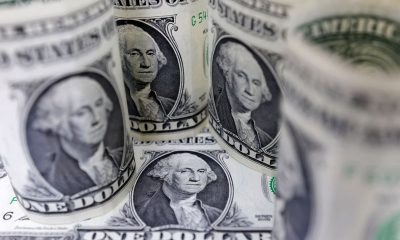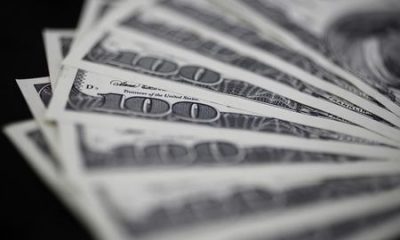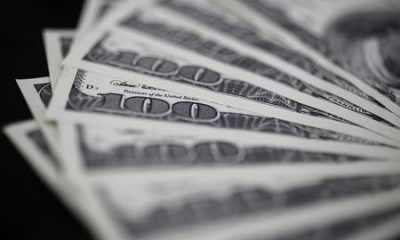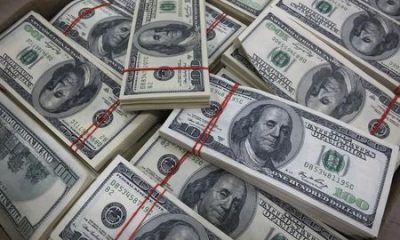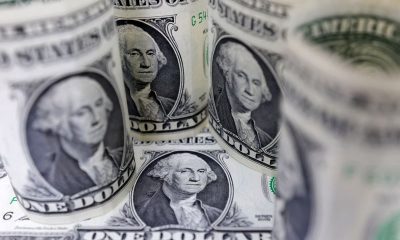Economy
Global shares mixed as U.S. tech stocks gain but inflation lingers


© Reuters. FILE PHOTO: An electronic board shows stock indexes at the Lujiazui financial district in Shanghai, China, March 21, 2023. REUTERS/Aly Song/File Photo
By Lawrence Delevingne and Naomi Rovnick
(Reuters) -Global shares were mixed and benchmark Treasury yields were steady on Friday as stock indexes rose on data showing U.S. inflation rose largely in line with expectations and a rally in technology shares.
Monthly underlying inflation picked up last month, largely driven by housing costs, a U.S. Commerce Department report on Friday showed. With spending seen cooling off in early 2024 as savings accumulated during the COVID-19 pandemic run out, most economists believe the Federal Reserve is done raising interest rates, though risks of a rate hike remain.
“Core inflation continues to lose speed,” Jeffrey Roach, chief economist for LPL Financial (NASDAQ:) in Charlotte, North Carolina, said in an email. “This report will not likely change the Fed’s view that inflation will slow in the coming months as demand slows.”
The fell 0.16%, to 32,732, the gained 0.35%, to 4,151 and the added 1.16%, to 12,741.
Shares of internet retail giant Amazon.com (NASDAQ:) advanced 8% after beating sales estimates, while Intel Corp (NASDAQ:) jumped 9% after the chipmaker signaled personal computer market rebounding from a quarters-long slump.
MSCI’s all-country equity gauge rose 0.45% following reassuring news on Thursday that the U.S. economy expanded at its fastest rate for almost two years in the third quarter, while the European Central Bank (ECB) also held interest rates steady.
Europe’s share index was 0.9% lower and MSCI’s broadest index of Asia-Pacific shares outside Japan closed 1.1% higher after hitting a fresh 11-month low on Thursday.
SOFT LANDING?
The yield on the 10-year U.S. Treasury, which moves inversely to the price of the debt security and functions as a benchmark for global borrowing costs, was little changed at 4.862% after crossing 5% earlier in the week.
Bank of America strategists said that despite unexpectedly strong U.S. economic growth in the third quarter, a slowdown in the fourth quarter still made “a soft landing more likely than no landing.”
Globally, “markets continue to hope for disinflation to continue smoothly, but don’t take disinflation for granted,” they wrote in a note on Friday.
The Fed is widely expected to keep its funds rate in a range of 5.25%-5.5% next week, although Chair Jay Powell has said a strong economy and tight jobs market could warrant more rate rises.
The ECB on Thursday also held its deposit rate at a record high of 4%, although President Christine Lagarde signaled in comments after the decision that further monetary tightening was possible.
Oil prices rose as investors priced in fears of an escalation of conflict in the Middle East which could disrupt oil supplies.
was last up 0.87% at $83.93 per barrel and was at $88.75, up 0.93% on the day.
CURRENCY MOVES
In currency markets, the euro was steady at 1.059 per dollar, now down almost 14% in the last three months.
Thanks to rate rises and a robust U.S. economy, the index that measures the dollar’s strength against competing currencies has risen almost 5% in three months and was on track for a weekly gain, even as it ticked down slightly on the day.
The yen hit a new one-year low of 150.77 per dollar overnight and was last at 149.61. That put it not far off the three-decade low of 151.94 it touched in October last year that led Japanese authorities to intervene to prop up the currency.
Economy
Russian central bank says it needs months to make sure CPI falling before rate cuts -RBC


© Reuters. Russian Central Bank Governor Elvira Nabiullina attends a news conference in Moscow, Russia June 14, 2019. REUTERS/Shamil Zhumatov/File Photo
MOSCOW (Reuters) – Russia’s central bank will need two to three months to make sure that inflation is steadily declining before taking any decision on interest rate cuts, the bank’s governor Elvira Nabiullina told RBC media on Sunday.
The central bank raised its key interest rate by 100 basis points to 16% earlier in December, hiking for the fifth consecutive meeting in response to stubborn inflation, and suggested that its tightening cycle was nearly over.
Nabiullina said it was not yet clear when exactly the regulator would start cutting rates, however.
“We really need to make sure that inflation is steadily decreasing, that these are not one-off factors that can affect the rate of price growth in a particular month,” she said.
Nabiullina said the bank was taking into account a wide range of indicators but primarily those that “characterize the stability of inflation”.
“This will take two or three months or more – it depends on how much the wide range of indicators that characterize sustainable inflation declines,” she said.
The bank will next convene to set its benchmark rate on Feb. 16.
The governor also said the bank should have started monetary policy tightening earlier than in July, when it embarked on the rate-hiking cycle.
Economy
China identifies second set of projects in $140 billion spending plan


© Reuters. FILE PHOTO: Workers walk past an under-construction area with completed office towers in the background, in Shenzhen’s Qianhai new district, Guangdong province, China August 25, 2023. REUTERS/David Kirton/File Photo
SHANGHAI (Reuters) – China’s top planning body said on Saturday it had identified a second batch of public investment projects, including flood control and disaster relief programmes, under a bond issuance and investment plan announced in October to boost the economy.
With the latest tranche, China has now earmarked more than 800 billion yuan of its 1 trillion yuan ($140 billion) in additional government bond issuance in the fourth quarter, as it focuses on fiscal steps to shore up the flagging economy.
The National Development and Reform Commission (NDRC) said in a statement on Saturday it had identified 9,600 projects with planned investment of more than 560 billion yuan.
China’s economy, the world’s second largest, is struggling to regain its footing post-COVID-19 as policymakers grapple with tepid consumer demand, weak exports, falling foreign investment and a deepening real estate crisis.
The 1 trillion yuan in additional bond issuance will widen China’s 2023 budget deficit ratio to around 3.8 percent from 3 percent, the state-run Xinhua news agency has said.
“Construction of the projects will improve China’s flood control system, emergency response mechanism and disaster relief capabilities, and better protect people’s lives and property, so it is very significant,” the NDRC said.
The agency said it will coordinate with other government bodies to make sure that funds are allocated speedily for investment and that high standards of quality are maintained in project construction.
($1 = 7.1315 renminbi)
Economy
Russian central bank says it needs months to make sure CPI falling before rate cuts -RBC


© Reuters. Russian Central Bank Governor Elvira Nabiullina attends a news conference in Moscow, Russia June 14, 2019. REUTERS/Shamil Zhumatov/File Photo
MOSCOW (Reuters) – Russia’s central bank will need two to three months to make sure that inflation is steadily declining before taking any decision on interest rate cuts, the bank’s governor Elvira Nabiullina told RBC media on Sunday.
The central bank raised its key interest rate by 100 basis points to 16% earlier in December, hiking for the fifth consecutive meeting in response to stubborn inflation, and suggested that its tightening cycle was nearly over.
Nabiullina said it was not yet clear when exactly the regulator would start cutting rates, however.
“We really need to make sure that inflation is steadily decreasing, that these are not one-off factors that can affect the rate of price growth in a particular month,” she said.
Nabiullina said the bank was taking into account a wide range of indicators but primarily those that “characterize the stability of inflation”.
“This will take two or three months or more – it depends on how much the wide range of indicators that characterize sustainable inflation declines,” she said.
The bank will next convene to set its benchmark rate on Feb. 16.
The governor also said the bank should have started monetary policy tightening earlier than in July, when it embarked on the rate-hiking cycle.

 Forex2 years ago
Forex2 years agoForex Today: the dollar is gaining strength amid gloomy sentiment at the start of the Fed’s week

 Forex2 years ago
Forex2 years agoHow is the Australian dollar doing today?

 Forex1 year ago
Forex1 year agoUnbiased review of Pocket Option broker

 Forex2 years ago
Forex2 years agoDollar to pound sterling exchange rate today: Pound plummeted to its lowest since 1985

 Cryptocurrency2 years ago
Cryptocurrency2 years agoWhat happened in the crypto market – current events today

 World2 years ago
World2 years agoWhy are modern video games an art form?

 Stock Markets2 years ago
Stock Markets2 years agoMorgan Stanley: bear market rally to continue

 Economy2 years ago
Economy2 years agoCrude oil tankers double in price due to EU anti-Russian sanctions

